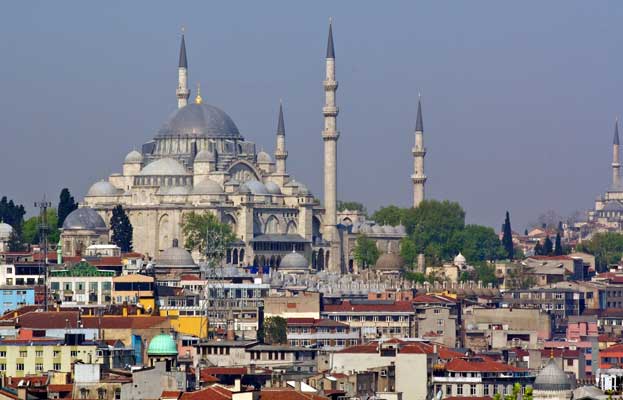Istanbul bears unique testimony to the Byzantine and Ottoman civilizations. Throughout history, the monuments in the centre of the city have exerted considerable influence on the development of architecture, monumental arts and the organization of space, in both Europe and Asia. Thus, the 6,650 m terrestrial wall of Theodosius II with its second line of defences, created in AD 447, was one of the leading references for military architecture even before St Sophia became a model for an entire family of churches and later mosques and before the mosaics of the palaces and churches of Constantinople influenced Eastern and Western Christian art.

Continent: Asia
Country: Turkey
Category: Cultural
Criterion: (I) (II) (III) (IV)
Date of Inscription: 1985
The Historic Istanbul
Istanbul was built at the crossroads of two continents; it was successively the capital of the Eastern Roman Empire, the Byzantine Empire and the Ottoman Empire, and it has constantly been associated with major events in political history, religious history and art history in Europe and Asia for some 20 centuries.At the same time, however, Istanbul is a large metropolis. With its population of some 3 million inhabitants, this historic city has undergone population growth in the past 30 years, which has profoundly changed its conservation conditions. The threat of pollution arising from industrialization and rapid and initially uncontrolled urbanization have jeopardized the historical and cultural heritage of the old town.
 |
| Historic Areas of Istanbul |
Browse Gallery Plus UNESCO Storyline
The World Heritage site covers four zones, illustrating the major phases of the city's history using its most prestigious monuments: The Archaeological Park, which in 1953 and 1956 was defined at the tip of the peninsula; The Süleymaniye quarter, protected in 1980 and 1981; The Zeyrek quarter, protected in 1979; The ramparts, protected in 1981. The ancient city and the capital of the Eastern Roman Empire are both represented: by the hippodrome of Constantine (324) in the Archaeological Park, by the aqueduct of Valens (378) in the Süleymaniye quarter, and by the ramparts built starting in 413 upon the order of Theodosius II, located in the last of the four zones.
The capital of the Byzantine Empire is highlighted by several major monuments. In the Archaeological Park there are the churches of St Sophia and St Irene, which were built in the reign of Justinian (527-65); In the Zeyrek quarter there is the ancient Pantocrator Monastery which was founded under John II Comnenus (1118-43) by the Empress Irene; in the zone of the ramparts there is the old church of the Holy Saviour in Chora (now the Kariye Camii) with its marvellous mosaics and paintings from the 14th and 15th centuries. Moreover, the current layout of the walls results from modifications performed in the 7th and 12th centuries to include the quarter and the Palace of the Blachernes.
The capital of the Ottoman Empire is represented by its most important monuments: Topkapı Saray and the Blue Mosque in the archaeological zone; the Sehzade and Süleymaniye mosques, which are two of the architect Koça Sinan's major works, constructed under Süleyman the Magnificent (1520-66) in the Süleymaniye quarter; and the vernacular settlement vestiges of this quarter (525 wooden houses which are listed and protected).
Browse All UNESCO World Heritage Sites in
Turkey. The original UNESCO inscription
Here!!!











No comments:
Post a Comment